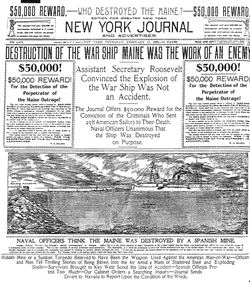Boiling Point

On February 15, 1898 an American battleship, the USS Maine, that was stationed in Havana harbor to protect U.S interests in Cuba during the rebellion was blown up. About 250 soldiers died in the explosion. Although nobody knew what happened or who caused the explosion, Spain was blamed, and because Teddy Roosevelt wanted something to bring America together, he pressed hard for America to intervene in Cuba. "Remember the Maine!" was the most famous rally cry that painted many newspapers after the explosion. Hearst and Pulitzer found the explosion to be a great opportunity to increase the circulation of their newspapers and targeted all American citizens. William Hearst sent a hired illustrator, Frederick Remington, to Cuba to record pictures of the reported battles. When he arrived in Cuba, Remington noticed that none of massive reported battles were actually happening. He cabled to Hearst,
"Everything is quiet. There is no trouble. There will be no war. I wish to return."
Supposedly, although Hearst denied it afterwords, he quickly wired back,
"Please remain. You furnish the pictures and I'll furnish the war."
In almost every newspaper, the headlines screamed that the culprit was the Spanish and urged America to take action. The newspapers were flooded with overblown and exaggerated stories of the Spanish atrocities such as General Weyler's death camps. President McKinley, who initially didn't want to take action in Cuba was now pressured by the enraged citizens of America and eventually gave in. Thus the beginning of the Spanish-American War.
"Everything is quiet. There is no trouble. There will be no war. I wish to return."
Supposedly, although Hearst denied it afterwords, he quickly wired back,
"Please remain. You furnish the pictures and I'll furnish the war."
In almost every newspaper, the headlines screamed that the culprit was the Spanish and urged America to take action. The newspapers were flooded with overblown and exaggerated stories of the Spanish atrocities such as General Weyler's death camps. President McKinley, who initially didn't want to take action in Cuba was now pressured by the enraged citizens of America and eventually gave in. Thus the beginning of the Spanish-American War.

